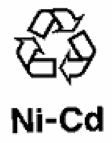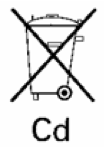Nickel Cadmium (NiCd)
Applications
- Rechargeable battery
- Used a broad range of handheld devices
Components
- Nickel, cadmium, steel, plastic
Risks / hazards
- Exposure to cadmium – a toxic substance
- Disposal to landfill can lead to local environmental contamination
Storage of used button cell batteries in the home
- Cover terminals with tape to prevent short circuit and minimise risk of fire
- Store out of reach and stored out of each of children
The photo above shows some examples of used NiMh batteries along with examples of how to protect the terminals.
Recyclability
- Used Ni-Cd batteries are recyclable, with a diversion rate from landfill of over 95%.
- Nickel, cadmium, steel & plastics are recovered
Collection rate
- 5.5%
Labels
UN Number
- 2795
Manufacturers
- None known
Legal requirements
- Ni-Cd batteries are a controlled waste. A waste storage licence and a waste transport licence are required in most jurisdictions. Interstate transport must be tracked, and some jurisdictions require intrastate tracking as well.
- Batteries must be packaged and transported in accordance with the Australian Dangerous Goods Code (ADG).
- The export of used batteries requires a permit from the Australian Government.
Companies with export permits
- Sims E-Recycling Pty Ltd
- HydroMet Corporation Pty Ltd
- Powercell (Australia) Trading Pty Ltd
- Beverich Holdings International Pty Ltd T/A Reverse E-Waste
- Waste nickel-cadmium batteries
- MRI (Aust) Pty Ltd
Health and safety
- Cadmium is a toxic metal. Cannot be disposed of in landfills
- High self-discharge; needs recharging after storage






